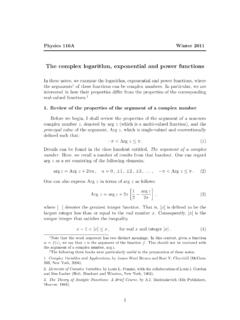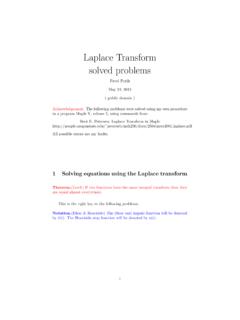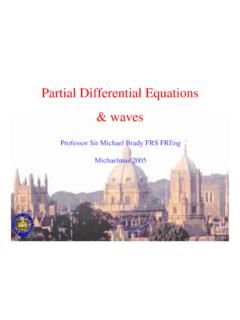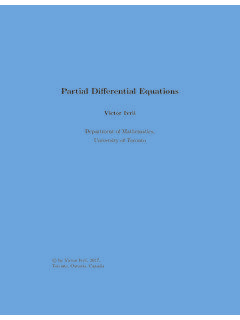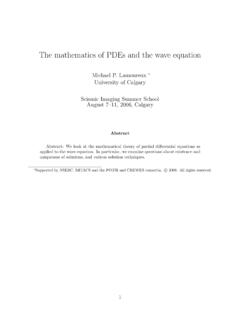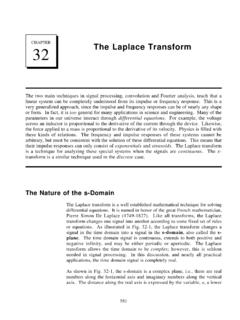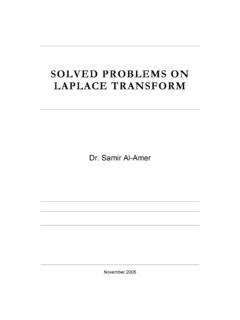Transcription of The SphericalHarmonics - Welcome to SCIPP
1 Physics 116C Fall 2012. The spherical harmonics 1. Solution to laplace 's equation in spherical coordinates In spherical coordinates, the Laplacian is given by 2.. ~ 2 1 2 1 1. = 2 r + 2 2 sin + 2 2 . (1). r r r r sin r sin 2. We shall solve laplace 's equation, ~ 2 T (r, , ) = 0 , (2). using the method of separation of variables, by writing T (r, , ) = R(r) ( ) ( ) . Inserting this decomposition into the laplace equation and multiplying through by r 2 /R . yields 1 1 d2 .. 1 d 2 dR 1 1 d d . r + sin + = 0. R dr dr sin d d sin2 d 2. Hence, 1 d2 sin2 d . 2 dR sin d d . 2. = r sin = m2 , (3). d R dr dr d d . where m2 is the separation constant, which is chosen negative so that the solutions for ( ) are periodic in , (.)
2 Eim . ( ) = for m = 0, 1, 2, 3, .. e im . Note that m must be an integer since is a periodic variable and ( + 2 ) = ( ). In the case of m = 0, the general solution is ( ) = a + b, but we must choose a = 0 to be consistent with ( + 2 ) = ( ). Hence in the case of m = 0, only one solution is allowed. One can now recast eq. (3) in the following form, m2.. 1 d 2 dR 1 1 d d . r = sin + = ( + 1) , (4). R dr dr sin d d sin2 . where the separation variable at this step is denoted by ( + 1) for reasons that will shortly become clear. The resulting radial equation, d2 R dR. r2 2. + 2r ( + 1)R = 0 , (5). dr dr 1. is recognized to be an Euler equation. This means that the solution is of the form R = r s.
3 To determine the exponent s, we insert this solution back into eq. (5). The end result is s(s + 1) = ( + 1) = s = or s = 1 . That is, (. r . R(r) =. r 1. Eq. (4) also yields m2.. 1 d d . sin + ( + 1) = 0. sin d d sin2 . Changing variables to x = cos and y = ( ), the above differential equation reduces to 2. m2.. 2 d y dy (1 x ) 2 2x + ( + 1) y = 0. (6). dx dx sin2 . This is the differential equation for associated Legendre polynomials, y(x) = P m (x) , for = 0, 1, 2, 3, .. and m = , + 1, .. , 1, . The restrictions of and |m| to non-negative integers with |m| is a consequence of the requirement that P m (x) should be non-singular at cos = 1. On p. 583, Boas gives the following result in eq.)
4 ( ), +m 1 2 m/2 d . P m (x) = (1 x ) x2. 1 , for m = , + 1, .. , 1, . (7). 2 ! dx +m The differential equation for the associated Legendre polynomials, given in eq. (6), depends on m2 and is therefore not sensitive to the sign of m. Consequently, P m (x) and P m (x). must be equivalent solutions and hence proportional to each other. Using eq. (7), it is straightforward to prove that ( m)! m P m (cos ) = ( 1)m P (cos ) . (8). ( + m)! . Combining all the results obtained above, we have found that the general solution to laplace 's equation is of the form im . r m e T (r, , ) = 1 P (cos ) im . r e where = 0, 1, 2, 3, .. and m = , + 1, .. , 1, . 2. 2. The spherical harmonics In obtaining the solutions to laplace 's equation in spherical coordinates, it is traditional to introduce the spherical harmonics , Y m ( , ), s (.)
5 (2 + 1) ( m)! = 0, 1, 2, 3, .. , Y m ( , ) = ( 1)m P m (cos ) eim , for 4 ( + m)! m = , + 1, .. , 1, . (9). m The phase factor ( 1) , introduced originally by Condon and Shortley, is convenient for applications in quantum mechanics. Note that eq. (8) implies that Y m ( , ) = ( 1)m Y m ( , ) , (10). where the star means complex conjugation. The normalization factor in eq. (9) has been chosen such that the spherical harmonics are normalized to one. In particular, these func- tions are orthonormal and complete. The orthonormality relation is given by: Z.. Y m ( , ) Y m ( , ) d = mm , (11). where d = sin d d is the differential solid angle in spherical coordinates.
6 The complete- ness of the spherical harmonics means that these functions are linearly independent and there does not exist any function of and that is orthogonal to all the Y m ( , ) where . and m range over all possible values as indicated above. The completeness property of the spherical harmonics implies that any well-behaved function of and can be written as . X. X. f ( , ) = a m Y m ( , ) . (12). =0 m= . for some choice of coefficients a m . For convenience, we list the spherical harmonics for = 0, 1, 2 and non-negative values of m. 1. = 0, Y00 ( , ) = . 4 . r 1 3. Y ( , ) = sin ei .. 1.. 8 .. = 1, r .. Y 0 ( , ) = 3. cos .. 1. 4 . r 1 15. Y22 ( , ) = sin2 e2i.
7 4 2 .. r 15.. = 2, Y21 ( , ) = sin cos ei .. 8 .. r 1 5.. 0. Y2 ( , ) = (3 cos2 1).. 2 4 . The corresponding spherical harmonics for negative values of m are obtained using eq. (10). 3. In addition, eq. (9) yields the following useful relation, r 0 2 + 1. Y ( , ) = P (cos ) , for = 0, 1, 2, 3, .. , (13). 4 . which relates the Legendre polynomials to the spherical harmonics with m = 0. In terms of the spherical harmonics , the general solution to laplace 's equation can be written as: X. X . T (r, , ) = (a m r + b m r 1 )Y m ( , ) . =0 m= . In particular, ~ 2 (a m r + b m r 1)Y m ( , ) = 0 .. Making use of eq. (1) for the Laplacian and using . 2 . r f (r) = ( + 1)f (r) , for f (r) = ar + br 1 , r r it follows from eq.
8 (2) that1. ~ 2 Y m ( , ) = ( + 1)Y m ( , ) . r 2 (15). 3. The laplace series As noted in the previous section, the completeness property of the spherical harmonics implies that any well-behaved function of and can be written as . X. X. f ( , ) = a m Y m ( , ) . (16). =0 m= . 1. Indeed, eq. (1) can be written as ~2. ~2= 1 . r 2 L. 2 , (14). r2 r r r ~ 2 is the differential operator, where L. 1 2.. ~2 1 . L sin , sin2 sin2 2. which depends only on the angular variables and . Then, eqs. (14) and (15) imply that: ~ 2 Y m ( , ) = ( + 1)Y m ( , ) . L. ~ 2 , with corresponding That is, the spherical harmonics are eigenfunctions of the differential operator L.
9 Eigenvalues ( + 1), for = 0, 1, 2, 3, .. 4. The coefficients a m can be determined from eq. (11). Namely, multiply both sides of . eq. (16) by Y m ( , ).. and then integrate over all solid angles. Using eq. (11), the right hand side of eq. (16) becomes . X. X. a m mm = a m . =0 m= . Dropping the primes, we conclude that Z. a m = f ( , )Y m ( , ) d . (17). Two special cases are notable. First, suppose that the function f ( , ) is independent of . In this case, we write f ( , ) = f ( ) and eq. (17) yields Z 2 Z 1. a m = N m e im . d f ( )P m (cos )d cos , 0 1. where we have written Y m ( , ) = N m P m (cos )eim , where N m is the normalization constant exhibited in eq.
10 (9). However, the integral over is straightforward, Z 2 . e im d = 2 m0 , 0. where the Kronecker delta indicates that the above integral is nonzero only when m = 0. Using eq. (13), we end up with p Z 1. a 0 = (2 + 1) f ( )P (cos )d cos . 1. This means that the laplace series reduces to a sum over Legendre polynomials, . 2 + 1 1. X Z. f ( ) = c P (cos ) , where c = f ( )P (cos )d cos . =0. 2 1. The coefficients c are related to the a 0 by r 2 + 1. c = a 0 . 4 . That is, for problems with azimuthal symmetry, the laplace series reduces to a sum over Legendre polynomials. The second special case of interest is one in which f ( , ) satisfies ~ 2 f ( , ) = ( + 1)f ( , ).




